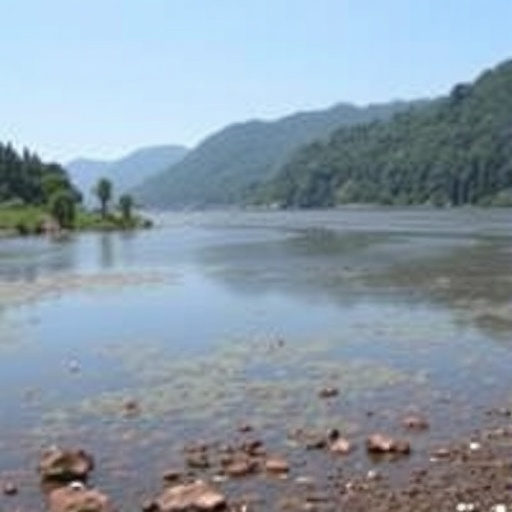In the heart of southeastern Brazil, a significant ecological inquiry has emerged focusing on the assessment and remediation of potentially toxic elements (PTEs) influencing the watershed of São Carlos, a region deeply intertwined with both natural biodiversity and anthropogenic activities. This investigation, led by a skilled team of researchers—including Neris, Costa, and Costa—is critical as it navigates the complex dynamics between ecological health and the contamination resulting from various pollution sources.
In recent years, the prevalence of PTEs, such as heavy metals and other harmful substances, has raised alarm bells across ecological and environmental forums. These elements, often stemming from industrial processes, agricultural runoff, and urban waste, pose serious risks to both human health and the environment. The intricate network of the São Carlos watershed serves as a vivid example of how natural systems can be adversely affected by human activities, bringing to the forefront the urgent need for effective remediation strategies.
The study implemented a robust ecological risk assessment framework that quantitatively evaluates the degree of contamination and the potential risks associated with PTEs in the watershed. This assessment is pivotal, as it lays the groundwork for understanding the magnitude of the problem and prioritizing the areas most at risk. Researchers meticulously collected samples from various points within the watershed to analyze the concentration of PTEs, unveiling a comprehensive profile of the contaminants present.
In tandem with the ecological assessment, the researchers deployed a preliminary mitigation strategy aimed at remediating the identified hotspots of contamination. This strategy is multi-faceted, involving both technological solutions and community engagement to ensure effectiveness and sustainability. By focusing on innovative remediation techniques, such as phytoremediation, the team underscores the potential of using native plant species to absorb and detoxify harmful metals from the soil and water.
The ecological implications of this work extend far beyond localized remediation efforts. Addressing PTE contamination is not simply a matter of cleaning up polluted areas; it has profound implications for biodiversity conservation. Healthy watersheds are vital for maintaining diverse ecosystems, providing habitats for myriad species, and supporting essential ecosystem services such as water purification, flood regulation, and carbon sequestration.
Furthermore, the socio-economic dimensions of this research cannot be overlooked. Communities situated in or near contaminated watershed areas often bear the brunt of health-related issues linked to PTE exposure. The integration of community response and engagement in the proposed mitigation strategies highlights a holistic approach, advocating for enhanced public awareness and participation in environmental stewardship.
As the researchers delve deeper into their findings, the data reveal patterns that hint at the broader environmental challenges facing Brazil today. With rapid urbanization and industrial growth, the São Carlos watershed exemplifies the delicate balance between development and conservation. This research not only provides insights specific to the region but also mirrors patterns observed in other urbanized watersheds around the globe, illuminating the universal nature of these environmental challenges.
The ramifications of this study reach far into the realms of policy and governance. The clear delineation of risk levels associated with PTEs can inform local and regional policymakers, guiding strategic decisions aimed at environmental protection and public health. The scientific grounding of the findings empowers decision-makers to advocate for stricter pollution controls and promote sustainable land-use practices that could mitigate future contamination risks.
Looking ahead, the need for continuous monitoring and adaptive management strategies becomes critical. As environmental conditions evolve, so too must the approaches to managing these ecosystems. The combination of empirical research and community involvement can pave the way for resilient socio-ecological systems that are better prepared to confront emerging environmental threats.
Moreover, the significance of interdisciplinary collaboration is underscored through this research. By tapping into the expertise of ecologists, chemists, public health professionals, and community leaders, more comprehensive solutions can emerge. This collective effort ensures that solutions are informed by diverse perspectives, fostering innovation and enhancing community resilience against environmental degradation.
In conclusion, the ecological risk assessment and preliminary mitigation strategy developed by Neris and colleagues breathe new life into the dialogue surrounding environmental pollution and remediation in Brazil. As our understanding of PTEs and their impacts deepen, the approach adopted in São Carlos could serve as a model for other regions grappling with similar challenges. Through resilient ecosystems and informed communities, the future can be reimagined—one where human activities coexist harmoniously with the natural world, ultimately enriching the bio-diverse landscapes we inhabit.
As this research gains visibility, it promises to inspire similar initiatives across the globe, igniting a chain reaction of ecological assessments and community-driven remediation strategies. In a time when environmental consciousness is paramount, the findings from this pioneering study encourage a collective movement towards sustainable practices that prioritize both ecological integrity and human health.
Subject of Research: Contamination of potentially toxic elements (PTEs) in a southeastern Brazilian watershed.
Article Title: Ecological risk assessment and application of a preliminary mitigation strategy for the remediation of potentially toxic elements (PTEs) in a southeastern Brazilian watershed (São Carlos, SP, Brazil).
Article References: Neris, J.B., Costa, F.S., Costa, J.A.S. et al. Ecological risk assessment and application of a preliminary mitigation strategy for the remediation of potentially toxic elements (PTEs) in a southeastern Brazilian watershed (São Carlos, SP, Brazil). Environ Monit Assess 197, 1034 (2025). https://doi.org/10.1007/s10661-025-14479-4
Image Credits: AI Generated
DOI:
Keywords: Ecological risk assessment, potentially toxic elements, remediation strategy, São Carlos, Brazil, watershed management, environmental contamination, public health, biodiversity conservation.




